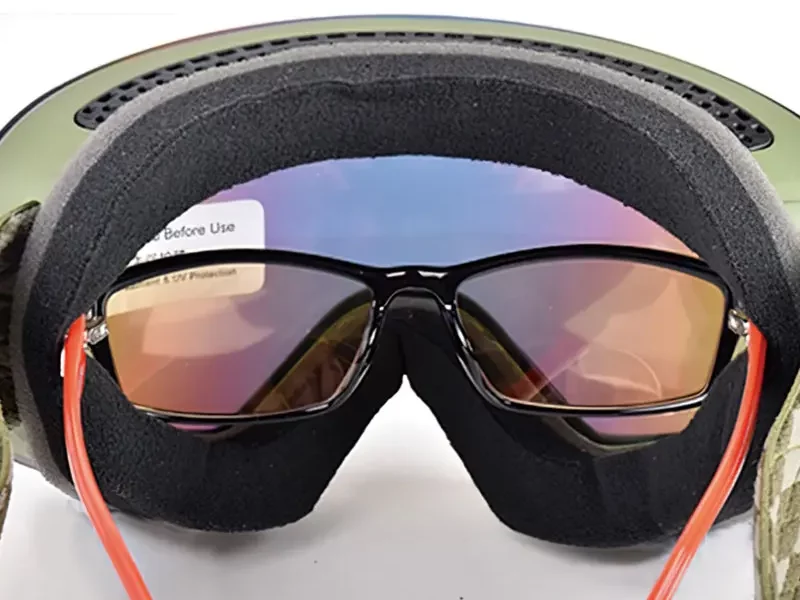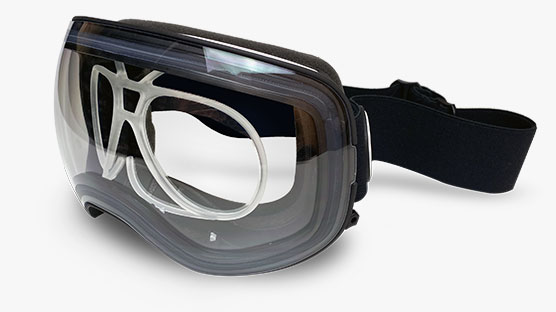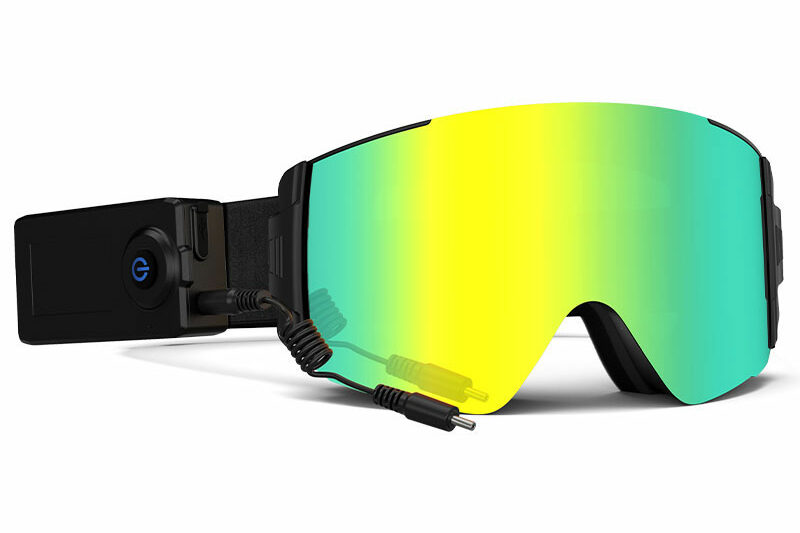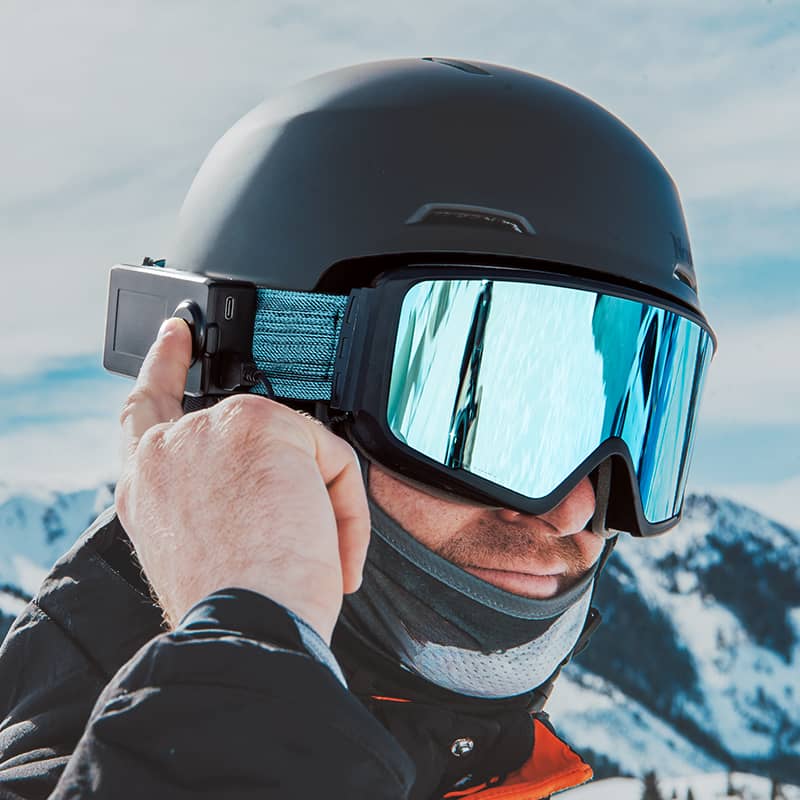Das Tragen einer Skibrille mit Brille kann für viele eine Herausforderung darstellen, aber keine Angst! Mit der richtigen Anleitung und den richtigen Tipps ist es durchaus machbar. Ob es darum geht, die perfekte Skibrille Ob Sie eine Brille suchen oder sich mit Skibrillen und Einlagen mit Sehstärke beschäftigen – wir haben die richtige Lösung für Sie. Klare Sicht auf der Piste ist entscheidend für ein angenehmes Skierlebnis, insbesondere für Brillenträger. Tauchen Sie ein in die Welt der Skibrillen und entdecken Sie die besten Möglichkeiten, Ihr Skierlebnis mit Brille zu verbessern.
OTG (Over the Glasses) Skibrille

Wenn Sie mit Brille auf die Piste gehen, ist die Wahl der richtigen Skibrille entscheidend für ein komfortables und klares Skierlebnis. Eine beliebte Option für Brillenträger sind OTG-Skibrillen (Over the Glasses).
OTG-Skibrillen sind speziell dafür konzipiert, bequem über Korrekturbrillen zu passen. Diese Brillen verfügen über einen breiteren Rahmen und eine tiefere Linse, sodass genügend Platz für die Brille bleibt, ohne dass es zu Unbehagen oder Druck im Gesicht des Trägers kommt.
Vorteile von OTG-Skibrillen
Der Hauptvorteil von OTG-Skibrillen besteht darin, dass sie das gleichzeitige Tragen zweier Brillenfassungen vermeiden. Personen, die auf eine Korrekturbrille angewiesen sind, bieten mit dieser Skibrille eine klare und ungehinderte Sicht und sorgen so dafür, dass die Sicht auf der Piste ungehindert bleibt.
Nachteile von OTG-Skibrillen
Obwohl OTG-Skibrillen eine praktische Lösung für Brillenträger darstellen, empfinden manche Nutzer sie im Vergleich zu herkömmlichen Skibrillen als sperriger. Die größere Größe kann die Ästhetik und die Passform beeinträchtigen und bei manchen Personen zu kleineren Unannehmlichkeiten führen.
Skibrillen-Einsätze mit Sehstärke

Korrektureinsätze für Skibrillen bieten eine praktische Lösung für alle, die beim Skifahren mit Brille eine Sehkorrektur benötigen. Diese maßgefertigten Einsätze passen perfekt in die Skibrille und bieten die nötige Sehkorrektur, ohne dabei Komfort oder Sehschärfe zu beeinträchtigen.
Vorteile von Korrekturgläsern
Einer der Hauptvorteile der Verwendung von Einlagen für Sehhilfen ist die Komfort und Sicherheit Sie bieten. Brillenträger können bequem mit korrigierter Sicht Ski fahren, ohne ihre normale Brille unter der Schutzbrille tragen zu müssen.
Zusätzlich, Korrektureinsätze können problemlos zwischen verschiedenen Skibrillen ausgetauscht werden, und bietet Flexibilität und Vielseitigkeit für Benutzer, die mehrere Brillen besitzen.
Nachteile von verschreibungspflichtigen Einlagen
Obwohl Korrekturgläser eine effektive Lösung zur Korrektur der Sehkraft beim Skifahren bieten, empfinden manche Nutzer sie möglicherweise als etwas hinderlich oder einschränkend. Die zusätzliche Schicht in der Brille kann das periphere Sehen beeinträchtigen oder zu einem engeren Sitz führen, was den Gesamtkomfort bei längerem Tragen beeinträchtigen kann.
Skibrillen mit Sehstärke

Skibrillen mit Sehstärke sind für Menschen mit Sehbehinderung, die gerne auf der Piste unterwegs sind, von entscheidender Bedeutung. Diese speziellen Skibrillen sind mit integrierten Korrekturgläsern ausgestattet, die auf die Sehstärke des Trägers abgestimmt sind und so eine nahtlose Lösung für klare Sicht beim Skifahren bieten.
Vorteile von Skibrillen mit Sehstärke
Die individuelle Anpassungsfähigkeit von Skibrillen mit Sehstärke macht sie zur idealen Wahl für Brillenträger, die eine maßgeschneiderte Lösung suchen. Ob es um die Anpassung der Linsentönung an unterschiedliche Lichtverhältnisse oder die Verwendung spezieller Beschichtungen zur Beschlagsvermeidung geht – diese Brillen bieten Vielseitigkeit und Komfort.
Darüber hinaus bieten Skibrillen mit Sehstärke eine bequeme und bequeme Passform Speziell für Brillenträger entwickelt. Dies gewährleistet ein sicheres und stabiles Brillenerlebnis ohne Kompromisse bei Stil oder Sehleistung.
Nachteile von Skibrillen mit Sehstärke
Obwohl Skibrillen mit Sehstärke zahlreiche Vorteile bieten, finden manche Benutzer sie relativ teuer im Vergleich zu anderen Alternativen. Das spezielle Design und die Anpassungsmöglichkeiten können zu einem höheren Preis führen, was für preisbewusste Skifahrer, die nach Lösungen zur Sehkorrektur suchen, eine Überlegung sein kann.
Tragen von Kontaktlinsen beim Skifahren und Snowboarden

Vorteile von Kontaktlinsen
Wenn es um Wintersport wie Skifahren und Snowboarden geht, bieten Kontaktlinsen eine sinnvolle Alternative für Personen, die keine Brille unter ihrer Skibrille tragen möchten. Das Tragen von Kontaktlinsen beseitigt die Unannehmlichkeiten und Beschwerden, die mit dem Tragen einer Brille verbunden sind bei diesen Aktivitäten. Darüber hinaus verringern Kontaktlinsen das Risiko des Beschlagens, das häufig beim Tragen von Brillengläsern unter der Skibrille auftritt, und sorgen so für klare und ungehinderte Sicht beim Befahren der Piste.
Nachteile von Kontaktlinsen
Trotz ihrer Vorteile ist es wichtig zu wissen, dass Kontaktlinsen möglicherweise nicht für jeden geeignet sind. Manche Personen empfinden das Tragen von Kontaktlinsen in kalten, windigen Umgebungen wie beispielsweise Skigebieten möglicherweise als unangenehm oder fühlen sich trocken. Darüber hinaus besteht die Gefahr, dass bei Stürzen oder anderen Aktivitäten mit hoher Belastung die Linse verloren geht, was das Skierlebnis möglicherweise beeinträchtigen könnte.
Überlegungen für Kontaktlinsenträger
Für alle, die beim Skifahren oder Snowboarden Kontaktlinsen tragen möchten, ist die richtige Augenpflege und Linsenpflege entscheidend. Achten Sie unbedingt darauf, dass die Linsen sauber und frei von Schmutz sind, um Beschwerden oder Reizungen bei Outdoor-Aktivitäten zu vermeiden. Tageslinsen minimieren das Risiko von Schmutzablagerungen und bieten zusätzlichen Komfort, da sie nach dem Tragen nicht gereinigt und aufbewahrt werden müssen.
Was ist die beste Lösung zum Skifahren, wenn Sie eine Brille tragen?

Bei der Wahl der optimalen optischen Lösung für das Skifahren mit Brille ist es wichtig, die verschiedenen verfügbaren Optionen zu vergleichen und ihre jeweiligen Vor- und Nachteile abzuwägen. Durch die Bewertung dieser Lösungen können Sie eine fundierte Entscheidung treffen, die Ihren individuellen Bedürfnissen und Vorlieben entspricht.
- OTG-Skibrille: OTG-Skibrillen sind eine praktische Lösung für alle, die beim Skifahren lieber ihre normale Brille tragen. Sie bieten zwar eine klare und ungehinderte Sicht, manche Nutzer empfinden sie jedoch im Vergleich zu herkömmlichen Skibrillen als sperriger.
- Rezeptbeilagen: Korrektureinsätze in Skibrillen bieten eine bequeme Möglichkeit, mit korrigierter Sehkraft Ski zu fahren, ohne eine normale Brille tragen zu müssen. Manche Personen empfinden sie jedoch bei längerem Tragen als etwas hinderlich oder einschränkend.
- Skibrillen mit Sehstärke: Diese Spezialbrillen verfügen über integrierte Korrekturgläser, die auf die Sehstärke des Trägers abgestimmt sind. Sie bieten einen bequemen und individuellen Sitz, sind aber im Vergleich zu anderen Alternativen relativ teuer.
- Kontaktlinsen: Kontaktlinsen bieten eine Alternative zum Tragen einer Brille unter der Skibrille, da sie das Risiko des Beschlagens und des Unbehagens, das mit dem Tragen einer Doppelbrille verbunden ist, vermeiden. Manche Personen können jedoch in kalten, windigen Umgebungen unter Trockenheit oder Unbehagen leiden.
So verhindern Sie das Beschlagen der Skibrille
Antibeschlagtechniken
Wenn Sie beim Skifahren eine klare und beschlagfreie Sicht mit einer Brille unter der Skibrille wünschen, gibt es verschiedene Antibeschlagtechniken und -produkte, die die Sicht deutlich verbessern können.
- Entdecken Sie Antibeschlagbeschichtungen und -tücher: Viele Hersteller bieten spezielle Antibeschlagbeschichtungen und -tücher an, die das Beschlagen von Skibrillen verhindern sollen. Diese Produkte bilden einen dünnen, transparenten Film auf der Innenseite der Brille und reduzieren so die Feuchtigkeitsbildung, die zum Beschlagen führt.
- Richtige Belüftung und Passformanpassung: Eine ausreichende Belüftung der Skibrille ist unerlässlich, um das Beschlagen zu minimieren. Achten Sie auf Antibeschlagbrille Mit durchdachten Belüftungssystemen, die den Luftstrom fördern und gleichzeitig das Eindringen von Schnee und Schmutz verhindern. Zusätzlich können Anpassungen der Passform für einen dichten und dennoch atmungsaktiven Verschluss die klare Sicht durch die Reduzierung von Kondensation gewährleisten.
Tipps für beschlagfreie Sicht
Klare Sicht durch beschlagfreie Gläser unter der Skibrille ist entscheidend für ein angenehmes Skierlebnis. Hier sind einige Tipps, um Beschlagen vorzubeugen und optimale Sicht zu gewährleisten:
- Wärmen Sie Ihre Schutzbrillen und Brillen vor: Bevor Sie auf die Piste gehen, können Sie Ihre Skibrille und andere Brillen vorwärmen, um Kondensation und Beschlagen zu vermeiden. Legen Sie sie dazu in einen warmen Raum oder nutzen Sie Ihre Körperwärme, um sie sanft anzuwärmen, bevor Sie sich in kältere Temperaturen begeben.
- Sorgen Sie für einen festen und sicheren Sitz: Der richtige Sitz der Skibrille ist entscheidend für die Luftzirkulation und reduziert Beschlag. Passen Sie die Bänder so an, dass sie sicher und dennoch bequem sitzen und ausreichend Luft um Ihre Brille zirkulieren können. Eine gut sitzende Skibrille minimiert Feuchtigkeitsstau und verhindert so, dass Beschlag Ihre Sicht behindert.
Durch die Umsetzung dieser Antibeschlagtechniken und Tipps zur Erhaltung einer klaren Sicht können Skifahrer mit Brille eine ungehinderte Sicht auf die atemberaubende Winterlandschaft genießen und gleichzeitig sicher die Pisten hinunterfahren.
Abschluss
Zusammenfassend lässt sich sagen, dass es für Brillenträger entscheidend ist, die richtige Brillenlösung zum Skifahren zu finden, um ein komfortables und klares Erlebnis auf der Piste zu gewährleisten. Ob OTG-Skibrille, Korrekturgläser, Skibrille mit Sehstärke oder Kontaktlinsen – es gibt verschiedene Optionen, die ihren Bedürfnissen gerecht werden. Durch Abwägen der Vor- und Nachteile jeder Option können Sie eine fundierte Entscheidung treffen, die Ihren Vorlieben und Anforderungen an die Sehkorrektur entspricht. Eine professionelle Beratung durch einen Optiker ist dabei sehr zu empfehlen.


25年-香港展邀请函(横屏-英文版)-1024x358.jpg)

